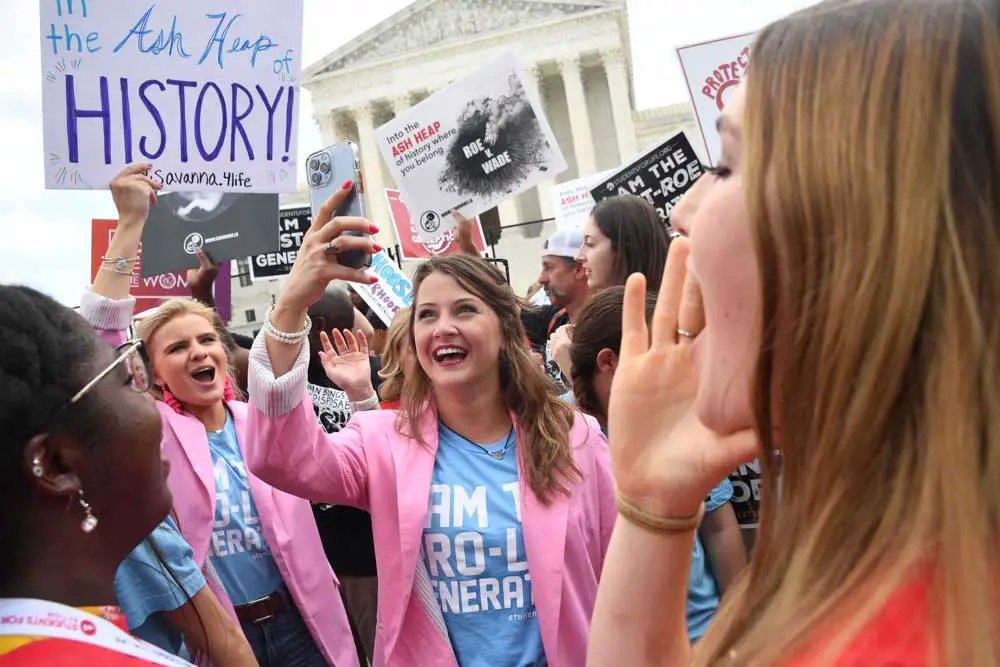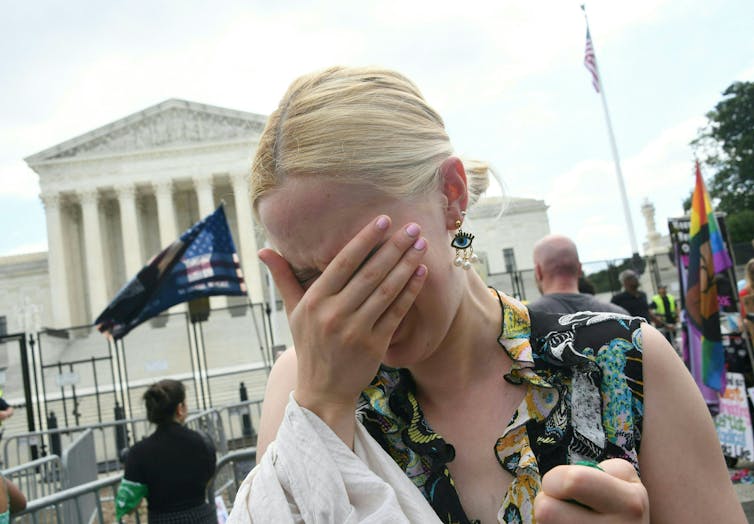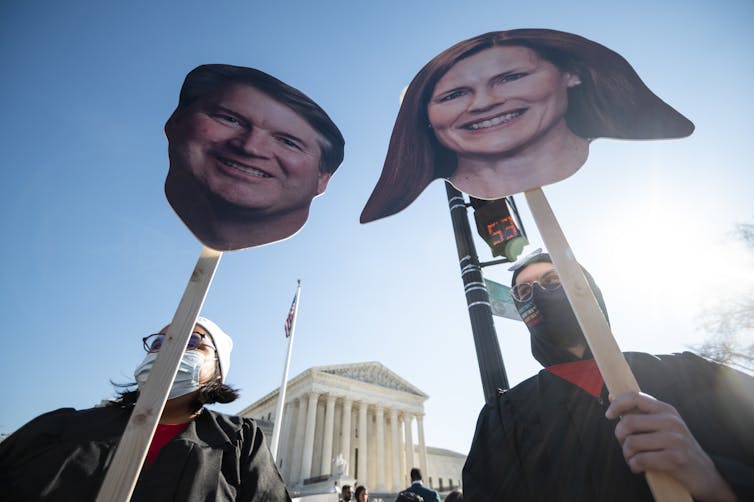
The Supreme Court’s decision to reverse 50 years of constitutional protection for the right to get an abortion is more than 200 pages long. Morgan Marietta, a political scientist at the University of Massachusetts, Lowell, and editor of the annual SCOTUS series at Palgrave Macmillan, studies the ideas and ideology of the court. We asked him to illuminate the thinking that lies behind the momentous decision.
What does this ruling mean?
This is a revolutionary ruling. Not just for abortion, but for the ongoing debates over the nature of rights under the Constitution.
The ruling signals a massive change in how we read the Constitution, from a living reading to an original reading. The court has firmly rejected the theory of the living Constitution, which argues that the meaning of the document’s language changes as the beliefs and values of Americans change.
The living view, which prevailed at the Supreme Court during the second half of the 20th century, means that additional rights can emerge over time, including abortion, privacy and same-sex marriage. The living Constitution is updated through the judgment of the justices of the Supreme Court, who determine when public values have changed, and hence new rights have emerged.
Originalism, which is the approach taken by the justices who overruled Roe, rejects the living Constitution. In the originalist view, the Constitution is static until officially altered by amendment. It does not evolve on its own without public approval. The role of the justices is to determine the original public meaning of the text, but to leave other decisions to democratic representation through elections.
Regarding abortion, the conclusion of Dobbs is clear: “The Constitution does not prohibit the citizens of each State from regulating or prohibiting abortion. Roe and Casey arrogated that authority. We now overrule those decisions and return that authority to the people and their elected representatives.”
“Arrogated” is an unusual word; it means to take without justification, implying that it is done in an arrogant way. That is the core argument of Dobbs: Roe was the court being arrogant, taking power the justices didn’t have, which rightly belongs with “the people,” a Revolutionary-era term in a revolutionary ruling.

Olivier Douliery/AFP via Getty Images
Why is there now no right to abortion, when Roe recognized it?
The new originalism of the court’s majority argues that if a right is present in the text and original public meaning of the Constitution, including the Bill of Rights and any other amendments, then the decision is beyond the reach of majority rule. But rights must be clear and established in order to wield that sort of influence.
The explicit rights clearly described and enumerated in the Bill of Rights — freedom of religion, freedom of speech, freedom to bear arms and others — are rising in influence, specifically because they have been approved and ratified by the people.
But the other evolved or implicit rights that have been recognized by the court over time – abortion and gay marriage, among others – are simply not constitutional rights in the view of the new majority. Enumerated rights – the ones specifically spelled out in the Bill of Rights – will be accorded stronger protections, while the recently recognized rights of the living Constitution will not be protected.
Under Roe, the majority saw abortion as within the category of rights. Hence it received constitutional protection. But under the new abortion decision, it should be governed by majority rule, the kind of question that is to be determined by the citizens of each state through their legislatures.
Even the originalist justices, however, recognize that there are some unenumerated rights which, though not spelled out in the Constitution, should be given constitutional protection. The Ninth Amendment explicitly argues for their existence: “The enumeration in the Constitution, of certain rights, shall not be construed to deny or disparage others retained by the people.”
So how do we know what those rights are? The court has settled on something known as the Glucksberg standard from 1997: Americans hold those additional rights that are “deeply rooted in the Nation’s history and tradition.”
In other words, if during the early phase of American history – roughly the 100-year period between the founding and the 14th Amendment, the 1770s to the 1870s – Americans publicly asserted the existence of a right, then it exists. But if they did not, then it does not exist. Under the Glucksberg standard, there has to be clear historical evidence from public debates, political speeches or judicial rulings that the right was asserted and recognized.
In Justice Samuel Alito’s majority opinion in Dobbs, he provides a review of the history of abortion: “The inescapable conclusion is that a right to abortion is not deeply rooted in the Nation’s history and traditions. On the contrary, an unbroken tradition of prohibiting abortion on pain of criminal punishment persisted from the earliest days of the common law until 1973,” Alito writes.
In the future, the court may rely on its own reading of history to determine which rights exist under the Constitution. But if the record is uncertain, the justices are far more likely to allow states to decide for themselves, rather than “usurp the power to address a question of profound moral and social importance that the Constitution unequivocally leaves to the people,” wrote Alito.

Bill Clark/CQ-Roll Call, Inc via Getty Images
Is a fetus now a person?
Each state will decide.
The abortion debate has two core questions: Is there a right to abortion? And is a fetus a person?
Even if a right exists, this does not justify the killing of a person – who is another holder of rights. In Roe, the court decided for the nation what the boundaries of fetal personhood were in the early stages of pregnancy: A fetus could not be considered a person before viability at approximately six months, but states could decide during the last trimester. In Dobbs, the court changes course and allows each individual state to make its own determination.
Whether the court should decide disputed realities is a deeply divisive question. There was a fascinating case called Kahler v. Kansas decided in 2020, which addressed the specific question of who gets to decide disputed social facts. In that case it was the boundaries of insanity: Could Kansas define mental illness and hence the insanity defense differently than other states? Does there have to be one definition throughout the nation about such matters as what counts as legally insane, or can we have variation?
In a decision written by Justice Elena Kagan, the court ruled that when realities are uncertain, individual state legislatures could decide for themselves. The same now applies to the personhood of a fetus. The power of individual states to decide social realities within their borders is the future of many constitutional disputes.
As Alito writes: “In some states, voters may believe that the abortion right should be even more extensive that the right that Roe and Casey recognized. Voters in other States may wish to impose tight restrictions based on their belief that abortion destroys an ‘unborn human being.’”
What effect will the ruling have on other issues?
In overturning Roe, the majority’s opinion offers a new and weaker standard for overturning the past rulings of the court. Simply put, precedents will be easier to overturn in the future.
For 30 years, the Casey ruling, which upheld the core of Roe in 1992, has been considered the “precedent on precedent.” It established four considerations for the legitimate discarding of a previous decision: the ruling misunderstood the Constitution; it proved to be unworkable in practice; new facts have emerged; and it accounts for what are known as “reliance interests,” where citizens had been guided by a ruling in making decisions about their lives.
Dobbs reverses Roe by rewriting the law of precedent. This will open up many other cases for reversal.
The most significant change is what Alito calls “the quality of reasoning.” Rulings that “looked like legislation,” offered faulty history or created standards unjustified by the Constitution can be overruled under the Dobbs standard.
The ruling includes a footnote describing all of the recent cases in which the court has overturned precedents. It may be the longest footnote in contemporary Supreme Court history, coming in at over a page and a half. The conclusion is that the meaning of the Constitution is more important than the history of the court, so precedent “does not compel unending adherence to Roe’s abuse of judicial authority,” Alito wrote.
Contrary to much speculation and worry, the Dobbs ruling and the new majority will not overturn protections of interracial marriage, especially the landmark ruling in Loving v. Virginia. That ruling hinges on the equal protection clause of the 14th Amendment, which is also enshrined in the text and is clearly protected under an original reading.
But other nonenumerated, evolved or created rights that are not textually protected are now up for question. This includes the right of same-sex marriage recognized by Obergefell v. Hodges in 2015.
Questions of rights not explicitly protected by the Constitution – and therefore now in the hands of state legislatures – will rely much more heavily in the future on local democracy. Social movements, campaigns and elections, all at the state level, will become the main battleground of American rights.
![]()
Morgan Marietta is Associate Professor of Political Science at UMass Lowell.




























Shelly says
Can someone lease show me where in the Constitution that it says a woman has a right to an abortion? People have no clue what the reversal means.
Pierre Tristam says
Same place where it says she has an individual right to bear arms.
John T. Schroeder says
STOP, the right to bear arms shall not be infringed. Abortion was never a right in the constitution. Roe v. Wade should have never been federalized. Let the voters of each state decide, nobody is taking away the right to abort a living being. You just may have to travel to a Liberal state. Stop the nonsense, most conservatives believe there are times that abortion may be necessary. This reversal should calm your nerves, we are a federalist society. The reversal just puts the abortion issue back to the states so the voters of those states can decide, that’s what it should have been in the first place.
Sherry says
@ s. . . please tell me in the constitution where is says you have the right to “breathe air”?????
Just because a particular “right” IS NOT explicitly spelled out in the constitution. . . does not mean every other human right is NEGATED!!!
Skibum says
In his opinion supporting the Supreme Court’s majority decision to strike down Roe vs. Wade, Clarence Thomas suggested the court should review other precedents, including its 2015 decision legalizing same-sex marriage, a 2003 decision striking down laws criminalizing gay sex and a 1965 decision declaring that married couples have a right to use contraception. Rachel Maddow noted something of extreme significance Friday evening about what Thomas said, and more importantly, what he intentionally left out of his comments about other precedents that he would review. Remember that Thomas is in an inter-racial marriage. That also is one of the precedents that is NOT in the U.S. Constitution, but a prior Supreme Court ruling enshrined inter-racial marriages into law just like it did when it decided in the Roe decision that abortion was legal. So why did Thomas fail to include inter-racial marriages in the decisions that he would review in the future? Could it be that because HE is the beneficiary of that court decision, that he only wants to review prior Supreme Court decisions that he doesn’t agree with and that doesn’t affect him personally? I think it would be naive of any of us to think he didn’t have a personal motive in the comments he made.
Ray W. says
Thank you, Skibum.
Perhaps it is appropriate to note that the Exclusionary Rule is a substantive due process remedy created by the Supreme Court to address the issue that repeatedly came before federal courts: law enforcement officers failing to observe the 4th and 5th Amendment proscriptions against illegal searches and seizures. In 1914, the Supreme Court recognized the illegalities routinely committed by law enforcement officers but left it to the states to create their own remedies. Most states resolved the issue by permitting a criminal to sue the officer or officers in civil court. Then, in 1948, the Supreme Court created the original Exclusionary remedy, but applied it only to federal cases. In 1964, the Supreme Court, through the 14th Amendment, applied it to the states. The remedy is based on the concept known as substantive due process. As Justice Thomas wrote, the substantive due process rights established in other cases might also be reviewed and invalidated. Does this mean that a majority of the Court’s justices are waiting for the right case to strike down the Exclusionary Rule? That states will be free to pass legislation doing away with the long-established remedy of evidentiary exclusion resulting from illegal searches, seizures, and interrogations? As I have argued several times in previous comments, the issue was never Roe v. Wade; the issue is Marbury v. Madison, and the importance of legal precedent in American jurisprudence. Once Marbury is out of the way, anything can be justified, regardless of how the Court has ruled throughout its history. This is why the questions pertaining to “super” precedent have been asked of prospective justices during the confirmation process.
As an aside, I was taught long ago that some Constitutional scholars consider a Michigan law school professor to be the father of the substantive due process doctrine, dating from the late 1860’s. I don’t doubt that there exist other interpretations of the origins of the substantive due process doctrine. The first applications of the substantive due process doctrine involved state statutes creating protections for employees, in what might be described as economic substantive due process. The original cases pertained to the contractual 80-hour work week that was common late in the 19th century. One of the early cases involved a state statute that forbade an employer from requiring a working mother to sign an employment contract for more than 60 hours per week, because that state’s legislature deemed it critical for a working mother to have time to care for her children. Business interests took to case to the Supreme Court, hoping to continue to require mothers to sign contracts for 80-hour work weeks. This substantive due process line of cases died out in the 1920’s and ’30’s, largely after a series of state legislative enactments protecting worker’s rights had become established across the nation. What we now enjoy as a 40-hour work week was unknown to our 19th century forefathers. Will that line of cases also draw Supreme Court attention? Will it become normal again for employers to require employees to sign contracts requiring 80-hour work weeks?
Bill C says
This is not about the Constitution. It is about religious beliefs and that the Supreme Court chose to elevate one set of religious beliefs over all the others. THAT’S Unconstitutional!
Foresee says
If Alito et al want to be “old-timey” there’s a simple solution- just declare a fetus 3/5ths of a person. It worked to settle the status of slaves when the Constitution was “originally” written.
Pogo says
@Hope this helps someone
Abortion funds
https://www.google.com/search?q=Abortion+funds
Elsewhere:
Some damned good advice
https://www.youtube.com/watch?v=UdJvEGokuAk
Especially important for Florida
https://www.youtube.com/watch?v=jtxew5XUVbQ
Winter is coming.